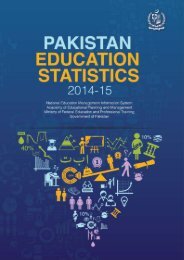CHILDREN
2a7YHer
2a7YHer
You also want an ePaper? Increase the reach of your titles
YUMPU automatically turns print PDFs into web optimized ePapers that Google loves.
Contents, continued<br />
Perspectives<br />
A fair chance for girls – End child marriage<br />
by Angélique Kidjo38<br />
Give children a chance<br />
by Gordon Brown66<br />
What are we waiting for?<br />
Sustainable societies begin with children<br />
by Kailash Satyarthi86<br />
Endnotes<br />
102<br />
List of Boxes<br />
BOX 1. Equity defined 7<br />
BOX 1.1. Female volunteers help health workers reach the marginalized in Nepal 23<br />
BOX 1.2. Every child counts: The importance of quality data on child survival 27<br />
BOX 1.3. Bangladesh shows the challenge of sustained progress in child survival 35<br />
BOX 1.4. Health Equity Funds provide free health care to the poor 36<br />
BOX 1.5. Eliminating malnutrition can help break the cycle of unequal opportunity36<br />
BOX 2.1. The developing brain: An early window of opportunity for learning50<br />
BOX 2.2. The destructive impact of armed conflict on education53<br />
BOX 2.3. Brazil and Viet Nam: Making the grade63<br />
BOX 3.1: Monetary child poverty measures72<br />
BOX 3.2. Measuring multidimensional child poverty74<br />
List of Figures<br />
Figure 1.1. Countries with limited economic growth can still reduce child mortality13<br />
Figure 1.2. Progress in under-five mortality does not necessarily come with greater equity14<br />
Figure 1.3. The poor will need to make faster progress to reach the 2030 goal15<br />
Figure 1.4. Progress must accelerate for the least advantaged children18<br />
Figure 1.5. Accelerated progress in neonatal mortality is key to meeting the SDG target22<br />
Figure 1.6. Many countries will miss the under-five mortality target, some by a wide margin25<br />
Figure 1.7. Antenatal care and skilled birth attendance save newborn lives29<br />
Figure 1.8. In 63 countries, equity in intervention coverage could reduce under-five mortality rates<br />
by almost 30 per cent30<br />
Figure 1.9. Many countries do not have enough health providers32<br />
Figure 2.1. More than half of the 59 million out-of-school children live in sub-Saharan Africa44<br />
iv THE STATE OF THE WORLD’S <strong>CHILDREN</strong> 2016



